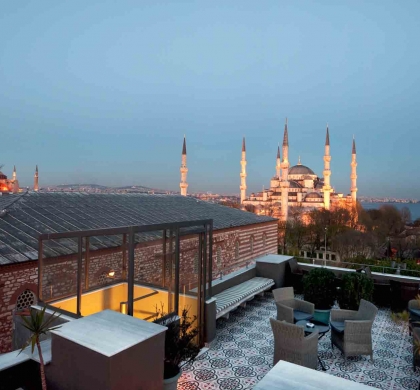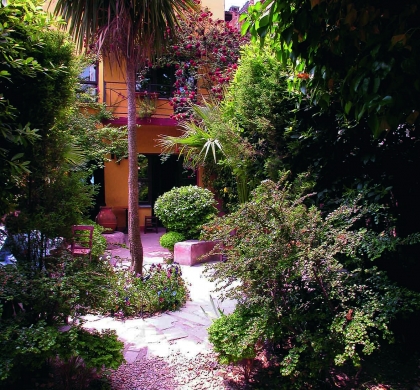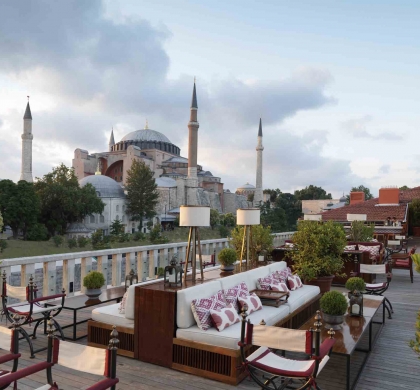Buy or gift a stand-alone digital subscription and get unlimited access to dozens of back issues for just £18.99 / $18.99 a year.
Please register at www.exacteditions.com/digital/cornucopia with your subscriber account number or contact subscriptions@cornucopia.net
Buy a digital subscription Go to the Digital EditionSüleyman the Magnificent’s city within a city above the Golden Horn has come to house one of the world’s finest collections of books and ancient manuscripts. By Caroline Finkel. Photographs by Simon Upton
A steady stream of visitors pours into the Süleymaniye Mosque, one of the key landmarks on the skyline of the old city of İstanbul: the classic building by the classic architect of the classical Ottoman age. Fewer visitors are able to perceive that the mosque, a lofty structure of space and geometry, is just one part of a vast complex of buildings designed by Mimar Sinan in the 1550s for the sultan whose name it bears. And hardly anyone is aware that some of the greatest treasures of the Süleymaniye lie tucked away down a narrow alley, concealed entirely from any tourist’s gaze.
These are the books and manuscripts of the Süleymaniye Library. The foundation deeds of the complex suggest that a library was established here in 1557; by 1561 its collection comprised 55 books that had been sent from the imperial palace, and a librarian was appointed to care for them. Today there are some 70,000 manuscripts in the library – making it the single largest collection of manuscripts in Arabic script - as well as some 40,000 printed books.
This unrivalled collection is housed in buildings which were once the first and second of the four medrese, or theological schools, attached to the mosque – the present reading room is the former school room of the Second Medrese. The twin quadrangles face each other across a lane that leads to the square on which stands the mosque itself. The feel is of college cloisters. Indeed, in the same garden courtyards where candidates training to staff the religious offices of the Ottoman Empire once relaxed after their studies, today Turkish and international scholars take a rest from their efforts to decipher nearly a thousand years of erudition.
For this is not a library for the casual researcher. The collections are almost entirely in the three great written languages of the Islamic world: Arabic, Persian and Ottoman Turkish. And mastering the language is merely the first stage. The subject matter of the manuscripts ranges from treatises on Islamic jurisprudence to philosophy and mathematics, from commentaries on the Koran to poetry and history.
The present library is only to a limited extent a direct descendant of the library of Süleyman’s mosque. Although collections of manuscripts were an integral part of work in the religious colleges, it was not until 1915 that the Sülemaniye Library began to take on its present form.
The first purpose-built library in Ottoman İstanbul was established much earlier, in 1678. It bears the name of its founder, the grand vizier Köprülü Mehmed Pasha, and still functions today under the administrative auspices of the Süleymaniye. Until that time, manuscripts were housed in cupboards in mosques. It was the book-loving Sultan Mahmud I who in the relatively peaceful years of the mid-eighteenth century decided to donate manuscripts from the palace to the existing collections in the imperial mosques. So to the collections of the Fatih Camii – the Mosque of Mehmet the Conqueror – came the palace’s precious store of this sultan’s manuscripts; and to the Süleymaniye Mosque came manuscripts once owned by Süleyman the Magnificent.
In 1740 Mahmud I established the library of Ayasofya. Many of the Empire’s most prominent men followed the sultan’s example and made donations to this library. Among the greatest treasures of the Süleymaniye today are works from Ayasofya, a Koran written on leather in the ninth century, and a volume of the fourteenth-century geography of ibn Fadlallah al-’Umari, another part of which was taken from Aleppo to the Paris library of Louis XIV in the seventeenth century. The oldest scientific work is an Arabic text of the work on conics by Apollonius of Perge, copied in 1024 AD.
Thus the Süleymaniye Library today houses what were formerly independent manuscript collections, as well as printed books, brought from all over the city and from a number of provincial towns. In addition to the Ayasofya collection, it includes the holdings of the imperial Fatih and Yeni Valide Mosques, as well as of the Süleymaniye itself. Manuscripts from many of the mosques built by members of the Ottoman ruling class in the seventeenth and eighteenth centuries are also here. Among these are the collections of another Köprülü scion, the grand vezir Amcazade Hüseyin Pasha, of the grand vezirs Çorlulu Ali Pasha, Damad İbrahim Pasha and Hekimoğlu Ali Pasha, of the two Şeyhülislam Feyzullah Efendi and Esad Efendi. The ownership of each volume in the Süleymaniye Library can be traced, and its whereabouts over the centuries ascertained, by studying the owner’s name stamped inside the cover.
A further five purpose-built libraries are subordinate to the Süleymaniye Library. The earliest of these is the aforementioned Köprülü Library; the others date from the eighteenth century – those of the notables Atif Efendi, Hacı Selim Apa and Koca Ragıp Pasha, and that of the imperial Nurosmaniye Mosque.
One of the most pressing problems facing the library is that of conservation, and its long-time director, Dr Muammer Ülker, has taken steps to provide for the future. In the garden behind the First Medrese stands a five-storey late-Ottoman town house, one of many that line the streets of the quarter, attesting to its former affluence and importance as a centre of learning. Restoration work on this house is transforming it into an atelier with laboratories and binding facilities where the manuscripts can be analysed and restored by conservators. Another activity is the publication of catalogues of the library’s collections.
One notable recent donation, by a retired naval captain, Nusret Hepgül, is of thirty albums containing more than 2000 marbled papers (ebrû), many dating from Ottoman times. For this is very much a living library. New collections are constantly added, with valuable bequests from the last generation of scholars and bibliophiles who, born in the final days of the Empire, were schooled in the Ottoman script before Atatürk’s reforms and continued to use it all their lives. Among the wealth of such gifts are the collections of the art historians Professor Süheyl Ünver and Nuri Arlasez and of the musician and music historian Rauf Yekta. The cultural value of this historic repository is clearly inestimable.
The traditional tent of Central Asian nomads is a pleasure dome fit for the gods, says Tim Beddow
Hekimbaşı Salih Efendi was the last Chief Physician to the Ottoman court, a scholar and a reformer. But plants were his passion. His gardens have gone, but the house lives on. By Patricia Daunt. Photographs: Simon Upton
The Victorian painter Frederick Leighton went to extraordinary lengths to create his pink, black, blue and gold domed Arab Hall in London. By Caroline Juler with photographs by Fritz von der Schulenburg
When the intrepid Lady Mary Wortley Montagu travelled with her husband’s embassy to Turkey in 1716, she recorded the minutiae of life on the road and in her ‘new world’. . Remarkably open-minded, her innocent observations inspired Ingres to paint some of the greatest erotic masterpieces of the Romantic movement.
‘There are not so many places left where magic reigns without interruption,’ wrote Freya Stark in The Lycian Shore, ‘and of all those I know, the coast of Lycia was the most magical.’ Barnaby Rogerson went with Rose Baring and four-month-old Molly in search of enchantment. Photographs by Faruk Akbas
Its rich, subtle flavour lends itself to a multitude of melting concoctions. Berrin Torolsan traces the story of this most lustrous fruit and serves up an irresistible feast.
More cookery features
In the early nineteenth century the redoubtable Englishman John Barker built a country retreat in the province of Hatay, close to the present-day Syrian border, planting his estate with exotic fruit trees, watching over the British Empire’s Indian Mail, and entertaining guests with music on the mechanical organ. David Morray looks back on the golden age of ‘Suedia Hall’
From the art capitals of the world, a round-up of Islamic and Orientalist art




Cornucopia works in partnership with the digital publishing platform Exact Editions to offer individual and institutional subscribers unlimited access to a searchable archive of fascinating back issues and every newly published issue. The digital edition of Cornucopia is available cross-platform on web, iOS and Android and offers a comprehensive search function, allowing the title’s cultural content to be delved into at the touch of a button.
Digital Subscription: £18.99 / $18.99 (1 year)
Subscribe now